Everyone knows that tooth brushing is an important part of daily hygiene. No matter what order it actually falls in, basically, you get up, you brush your teeth, and get ready for the day. Right before bed you brush your teeth, and you’re ready for the night. But what about your dogs, where do they fall? They have teeth, they get bad breath, and they form periodontal disease exactly the way humans do. And yet, many people don’t think twice about not brushing, or we hear: “My dog doesn’t like it.” Or “He won’t tolerate it.”
Brushing your dog’s teeth is just like any other training: keep it positive, make a routine of it, and keep at it. Sure, in the beginning you may feel like you’re not accomplishing much with your pup tossing his head around. But I promise, if you are getting the brush in the mouth, something is getting done. If you are still in the head tossing phase, how do you brush your pet’s teeth?
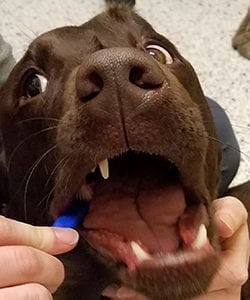
Fig. 1
First off, let’s be real, your dog may not sit there and let you brush. You may have to coerce a spouse, older child, sibling, friend, or the creepy guy down the street—okay maybe not that guy, but you get the idea; someone to help you hold your dog’s head still long enough for him to realize it’s not so bad. So now that you’ve bribed a family member or friend to help you, you next need your toothbrush. Make sure it is an actual brush, not the finger brush with the rubber bits on it. Those brushes don’t do much where you’re going. Also, we actually want to encourage a little chewing on the brush because it’s as close to your dog brushing his own teeth as you’re going to get and we don’t want your finger there. Next get the toothpaste flavor that your pup loves—chicken, beef, seafood—just make sure it’s pet safe. You never want to use human toothpaste because it contains fluoride and that’s toxic to everyone—it’s one of the reasons we spit ours out. Pet-safe toothpaste is safe to eat. It’s made to aid you in brushing because your dog will want to eat what’s on the end of the brush.
Now you’ve got your brush, you’ve got your toothpaste, and you’re ready to go, right? Not so fast. You as the human knows what’s going on, but for your loving canine companion all he sees is this weird, gooey, spiky thing coming for his face and suddenly you’re trying to pry his mouth open with that thing coming towards him. If your dog could talk he would be screaming, “No don’t do it! It’s going to eat me!” In short, not the ideal situation. (Dog Fig. 1)
So, if you can’t just start brushing, then where do you start? Remember I said earlier brushing is just like any other training? You need to break the process down and show your dog that there really isn’t anything scary, and maybe he might even like it.
Building Blocks of Brushing
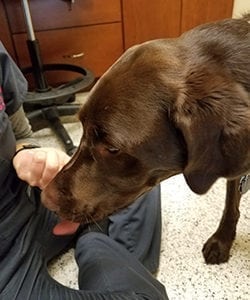
Fig. 2
• Offer the toothpaste like a treat.
Unless you’re already brushing on a regular basis, gel and paste are probably not part of your pup’s regular diet, so let him investigate. Let him lick the toothpaste off your finger, or off a treat, so he knows it’s okay. (Dog Fig 2)
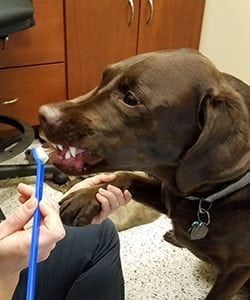
Fig. 3
• Offer the toothpaste on the brush.
Once he thinks the toothpaste is a good thing, add some to the brush and again let him investigate. Let him eat the toothpaste off the brush and if he wants to bite the brush, go for it, just don’t let him eat the brush. A little chewing is about as close as you’re going to get to him brushing his own teeth. Just be careful not to let his eating the toothpaste get in the way of all your efforts. (Dog Fig 3)
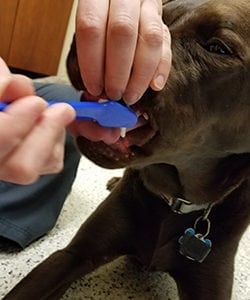
Fig. 4
• Start with the teeth you can see.
Begin the actual brushing process with some of the teeth in the front of the mouth, whether it’s the incisors (the little teeth between the fangs), or the canines themselves (the fangs) angle the brush towards the gum line and with light to moderate pressure brush. After you get through those few teeth, stop. Give your furry friend a special treat, something he doesn’t get often and use it to help train him to sit for the brushing process. It will also give him a second to unwind his doggy brain from what just happened. When everyone’s had a moment, go back and add in a couple more teeth, reward again. Then be done for that day. Tomorrow, do the same thing again, and add in more teeth, repeat until the whole mouth gets brushed. And yes this is a daily exercise, just like in your mouth. (Dog Fig 4)
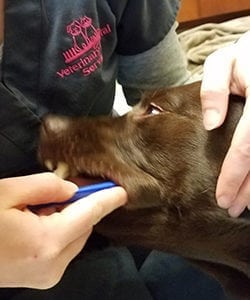
Fig. 5
• Brushing the back teeth.
When you get to the back of the mouth, you know those really big teeth you see when he pants, those teeth can be challenging to brush. Don’t pull the lip all the way back. I know it’s tempting to do so you can see what you’re brushing. However, cranking back on the lips like that can actually scare them, and we want to keep it positive. Instead, just move the lip back enough to slip the brush back there, then let the lip fall back down and listen for the brush to make contact with the teeth. (Dog Fig 5)
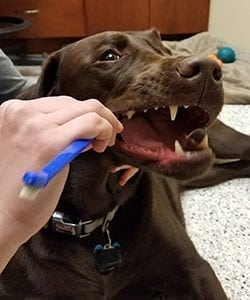
Fig. 6
Don’t worry, I promise you will be able to hear it and again angle that brush towards the gums. Keep in mind when brushing in the maxilla (upper jaw) there are usually two smaller teeth behind that big tooth. However, that big tooth sits right at the cheek bone so if you brushed straight back, you would miss the two smaller teeth. Instead, you need to swing the brush handle out so that the bristles look like you’re moving in to brush the center of his mouth. The angle is a little less than forty-five degrees (for all you techie people). (Dog Fig 6)
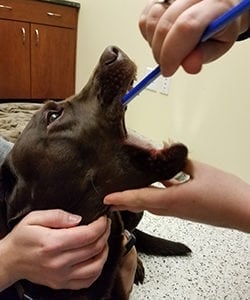
Fig. 7
• Brushing the insides of the teeth.
Now that your pup is comfortable with getting the outsides done, and he realizes the brush won’t eat him (and maybe he might even like what’s on the brush) you can start with the insides of his mouth. Start with the front of his mouth and add in a few teeth at a time, just like you did for the outsides. Add in a few more teeth every time you reenter the mouth working your way to the back, keeping it positive. You want to start from the front to keep the desire to chew to a minimum. If you were to enter the mouth from the side by the big chewing teeth, he’d want to start snacking on the brush and could totally derail your efforts. (Dog Fig 7)
Once the training part is over, which could take anywhere from a couple weeks to a couple months, the brushing process shouldn’t take you more than about a minute or two to get around the whole mouth. As a bonus, if you make it into a routine and do it at the same time every day, say when you brush your own teeth, eventually your super intelligent canine will cue in on what you’re doing and ask for his teeth to be brushed, even if really he’s only waiting for that super special treat he gets only after brushing. (If your pup is being particularly stubborn, check out these 7 hacks to help with brushing.)
If you have questions about your dog specifically, call us to make an appointment if you’re in the area and we can work with your pup.
